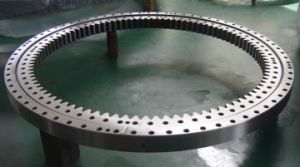
Stainless Steel Valve block
Valve blocks are specially designed and manufactured according to the application of each customer. They are manufactured with an advanced engineering approach meeting the circuit logic and functionality, performance, safety and installation expectations. Special valve block designs enable the creation of various control alternatives even for the machines such as sheet metal forming and pressure casting machines which bring developed solutions. Along with many advantages such as small sizes, low weights and being economic, our products are cleaner and reliable solutions with high leak tightness properties.
...more
Slewing Bearing
slewing bearings are machine elements which absorb all axial and radial forces and the resulting tilting moments in a single self-retaining and ready-to-install unit. Their low profile and an excellent weightperformance ratio, open center, and the possibility of an integrated gearing make Rotek slewing bearings ideal structural components. Slewing ring bearing solutions are ideal for optimal economy in a given envelope dimension; for heavy-duty applications requiring significant load-carrying capacity; for designs where precise positioning is critical; and for the unique requirements of wind turbines. Our slewing ring bearings offer total solutions for the most demanding specifications in a variety of applications, including: Aerospace and Engineering Heavy equipment Industrial machinery Medical systems Renewable energy Semiconductor manufacturing equipment
...more
Impellers
Without baffles, most impellers styles impose a tangential flow pattern. With baffles, most impellers show their true flow characteristics. Impellers are sorted here by the flow patterns they were intended to create, radial flow impellers and axial flow impellers. Click on any of these images for a larger picture. If you can't find your impeller design here, see if it is stored under Special Impellers . Impeller design data includes impeller dimensions, number of blades, turbulent power number, turbulent flow number, and impeller synonyms. If you see a More Data link, click on it for flow pattern information and possibly non-turbulent power numbers (Np), flow numbers (Nq) and discharge angles as a function of Reynold's Number (Re).
...more
Engine Block
Engine block or cylinder block – is consider the ” backbone ” of the engine to which all other parts are bolted or attached. Some Car manufacturers mass produced engine blocks but some made it one at a time for special cases. They used compacted sand and resin or sand cast to be it’s mold. They put a thin amount of carbon ( by torch ) that acts as a lubricant so that the molten metal will flow smoothly to the spaces of the sand cast. The raw molten metal is heated about 1300 deg. F before it will be poured in to the cast. After some time it will become a super strong aluminum alloy. They used powerful x-ray to scan the engine block to see if there is any microscopic cracks or floss in the metal. Slight vibration from a defect in the engine will be magnified at high speed and the engine could fail.
...more
Hydraulic Block Cylinder
The engine block is the linchpin of vehicles that run on internal combustion, providing the powerhouse for the vehicle. It is called a "block" because it is usually a solid cast car part, housing the cylinders and their components inside a cooled and lubricated crankcase. This part is designed to be extremely strong and sturdy, because its failure results in failure of the car, which will not function until the engine block is replaced or repaired. Most engine blocks are made of cast iron, although in the late 1990s, some made from plastic and other experimental materials were being used in prototype cars with the hope of developing more lightweight, efficient vehicles. A cast iron one can comprise a substantial portion of the weight of the car, and usually requires multiple people to be removed and worked on safely.
Type : Cylinder Blocks
Material : Steel
Shape : Cylindrical
Application : Casting And Foundry Industry
Feature : Corrosion Resistance, Cost Effective, Durable
...more
Crankshaft
A crankshaft contains two or more centrally-located coaxial cylindrical ("main") journals and one or more offset cylindrical crankpin ("rod") journals. The two-plane V8 crankshaft pictured in Figure 1 has five main journals and four rod journals, each spaced 90° from its neigbors. The crankshaft main journals rotate in a set of supporting bearings ("main bearings"), causing the offset rod journals to rotate in a circular path around the main journal centers, the diameter of which is twice the offset of the rod journals. The diameter of that path is the engine "stroke": the distance the piston moves up and down in its cylinder. The big ends of the connecting rods ("conrods") contain bearings ("rod bearings") which ride on the (offset) rod journals.
...more
Cylinder And Engine Blocks

metal spraying

Thermal Spraying

Block Components

antifriction bearings

Armature Rotors

Failure Analysis & NDT

Critical Repairs and Reclamation

Rebabbitting Services
Be first to Rate
Rate This